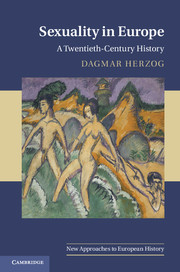Epilogue
Published online by Cambridge University Press: 05 June 2012
Summary
Looking backwards from the vantage-point of the early twenty-first century present, we can read the story of sexuality in twentieth-century Europe as eventually indeed a story of liberalization – but also one that was filled with tremendous conflicts. Without a doubt as well, the twentieth century witnessed a vastly intensified preoccupation with sexual matters. From the very beginning, there was heightened attention to issues pertaining to sex. In the midst of the emergence of the penny press, there was a powerful voyeuristic fascination with the doings of others; in the midst of worry about the spread of venereal disease, there was a useful opening for debating the sexual double standard and the prevalence of prostitution as a constant accompaniment to the institution of marriage; in the midst of growing efforts to separate sex from reproduction, there was intensified interest in contraceptive strategies and products. And in the midst of all this, there was increasing curiosity about the very nature of what sexual desire might be: Was it an internal drive seeking expression – or a pull toward another person? Did it involve love and affection or preferably not? Was the gender of the object choice significant or rather the particular practices that gave pleasure? Why did people do it? What exactly was it? Was sex a performance or a gift, a reassurance or a release, a process-oriented sensuous exploration or a goal-oriented endeavor, a means or an end? Was it a horror or a banality – or an absolute delight?
- Type
- Chapter
- Information
- Sexuality in EuropeA Twentieth-Century History, pp. 218 - 221Publisher: Cambridge University PressPrint publication year: 2011

